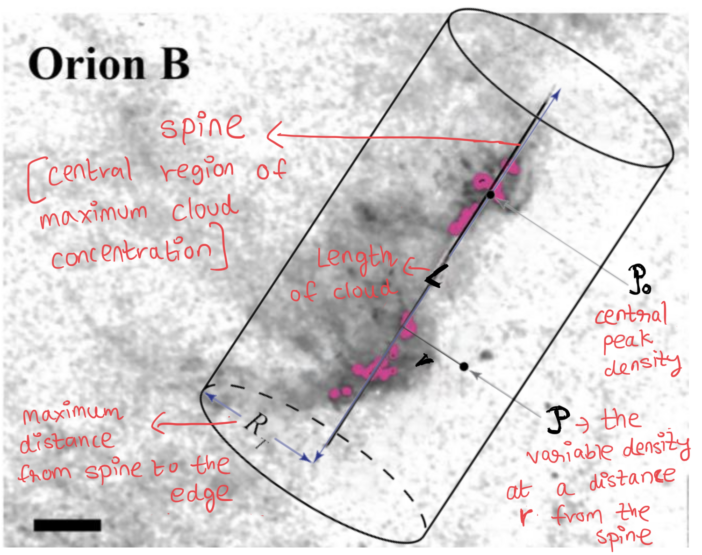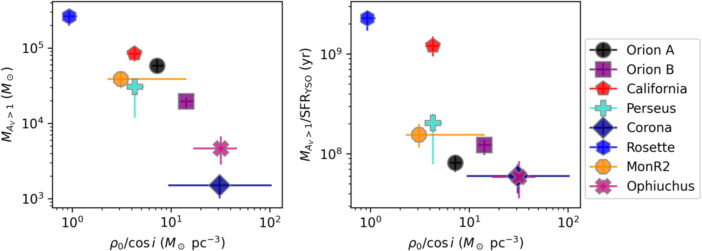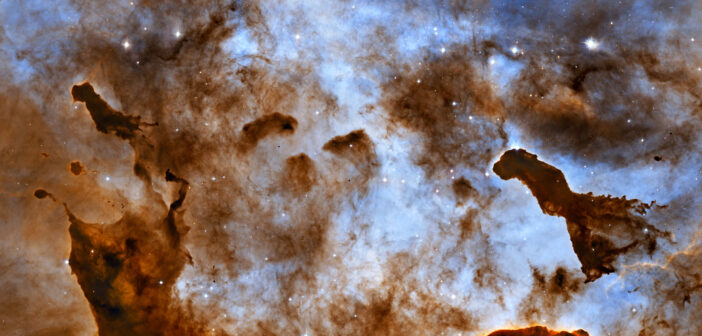Editor’s Note: Astrobites is a graduate-student-run organization that digests astrophysical literature for undergraduate students. As part of the partnership between the AAS and astrobites, we occasionally repost astrobites content here at AAS Nova. We hope you enjoy this post from astrobites; the original can be viewed at astrobites.org.
Title: The Global Structure of Molecular Clouds: I. Trends with Mass and Star Formation Rate
Authors: Nia Imara and John C. Forbes
First Author’s Institution: University of California, Santa Cruz
Status: Published in ApJ
Molecular clouds are stellar nurseries, the birthplace of stars in our universe. These clouds are made up of cold molecular hydrogen, H2, which can clump together and collapse to form stars. Despite being such a vital part of the universe, the physics behind molecular clouds still needs to be better understood. Observations of molecular clouds provide limited information about their three-dimensional structure, making it challenging to study what exactly it is about these clouds that enable them to form stars.
Creating models that resemble molecular clouds is an excellent way to understand them in great detail. Comparing the models to actual observations enables us to tweak the model so that it matches all the observational properties of the object, thus letting us use the properties of the model to study the properties of the actual object.
So, how does one go about building a model of a molecular cloud? A good place to start would be to see how these structures look through a telescope. Observations indicate that most molecular clouds have an elongated shape with more gas concentrated near a central axis. The next step would be to pick a geometrical shape that best resembles the observations, preferably well studied and having well-defined properties. Even though our first instinct is to model the clouds as a sphere (because everything can be assumed to be a sphere!), the authors of today’s article take a more reasonable approach and model the molecular clouds as a cylinder.
Rolling in the Deep (Space)
The next step in building a good model would be to justify why this model is the closest to the molecular cloud. The comparison between the model adopted and an actual molecular cloud is highlighted in Figure 1.

Figure 1: The cylindrical model plotted on top of the observed extinction map of a molecular cloud, with the various parameters defined in red. The pink signifies regions of high extinction. [Imara & Forbes 2023 with annotations by Archana Aravindan]
How do you know if the model you’ve built is a good one? You test to see how well it replicates the properties of a real molecular cloud! To do this, the authors collected high-resolution observations of a sample of molecular clouds. Density is an important term that needs to be compared to observations, but density measurements are hard to obtain directly from the 2D projections of the clouds. A good approximation would be to get maps of dust extinction, which can be used as a proxy for density. There are well-established relations in place that relate dust extinction to surface density, so the authors use these relations to test their models.
Does the Model Have It All?!
The authors determined that all the clouds in their sample could be represented well by the cylindrical model. They also noted some significant correlations between the model parameters and the observed cloud properties (Figure 2). Clouds with the highest central densities have the lowest mass and star formation rates. High density coincides with high star formation rates since the denser the gas, the higher the chances for stars to form. However, the fact that such clouds have a low total mass seems counterintuitive. The authors determine that the mass of the cloud depends on both the distance along the spine and the perpendicular distance from it. They also find that dense clouds have short depletion times: the time needed to convert all the available molecular gas into stars at the current star formation rate. This gives us a correlation between the structure of the clouds and the timescales on which they would form stars.

Figure 2: The correlation between the mass (left) and depletion times (right, indicated as Mass/Star formation rate) on the y axis with the density (given as ρo/cos i to account for the inclination of the cloud) on the x axis for the observed sample of molecular clouds. As the density increases, both the mass of the cloud and the depletion times decrease. [Imara & Forbes 2023]
Original astrobite edited by William Balmer.
About the author, Archana Aravindan:
I am a third-year PhD student at the University of California, Riverside, where I study black hole activity in small galaxies. When I am not looking through some incredible telescopes, you can usually find me reading, thinking about policy, or learning a cool language!

